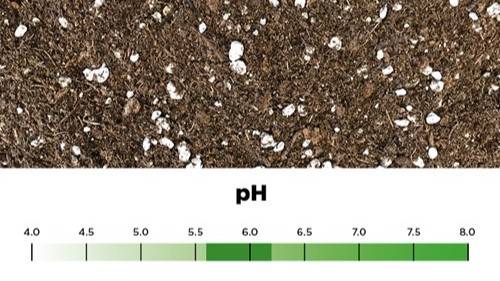How to Maintain the Proper pH of a Growing Medium


When asked “How do you maintain the proper pH of a growing medium?”, often the answer is to adjust the water pH to achieve a growing medium pH in the ideal range of 5.6-6.2. This is simply not true.
Many hydroponic companies suggest nutrient programs that use reverse osmosis to strip the water of all mineral elements and then use a series of fertilizers to reintroduce the elements removed and add those elements needed to maintain proper vegetative plant growth and flowering. By doing so, the theory is that the growing medium pH should remain stable and not drift into unwanted ranges and proper fertility levels can be maintained. Although it is possible for this to work, the majority of growers experience pH drift problems with their growing medium with this approach.
Growing Medium pH: Treat Like Hydroponics or Soil?
When it comes to adjusting the pH of PRO-MIX and other soilless growing media, these substrates should be viewed as a hybrid between hydroponic solution and soil. Soilless growing media have slightly similar pH management properties and ideal ranges as hydroponic systems because their pH changes somewhat quickly over time compared to soil. But soilless growing medium is more like outdoor soils because pH change is not instant, and a soilless growing medium is like a filter that retains some elements coming from the water, fertilizer and the plant that directly alter the pH of the growing medium.
What Changes Growing Medium pH?
Contrary to popular belief, the pH of the water does not influence the pH of the growing medium. It is the bicarbonate and carbonate levels in the water, known collectively as alkalinity, the potential acidity or basicity of the fertilizer and the plant itself:
Water Alkalinity
As stated above, water alkalinity is a measurement of carbonates and/or bicarbonates in the water, or another way to put it is the amount of limestone dissolved in the irrigation water. The higher the alkalinity, the faster the pH of the growing medium climbs regardless of the water pH (Figure 1). If water is passed through a reverse osmosis unit, then alkalinity is very low, so the water does not cause the pH of the growing to rise quickly. Reverse osmosis units are not necessary for most water sources if the fertilizer is properly matched to the water profile and the crop grown.

Fertilizer
Quality water soluble fertilizers typically have the potential acidity or potential basicity posted on their labels to predict their influence on the pH of soilless growing medium, such as PRO-MIX and others. For example, the higher the potential acidity of the fertilizer, the more acid it is. This is often determined by the ratio of nitrogen forms. Ammonium and urea are acidic forms of nitrogen which cause growing medium pH to drop and nitrate is basic which causes growing medium pH to rise. Therefore, if your water has high alkalinity, a fertilizer that has a higher ratio of ammonium to nitrate can be used to minimize pH climb in a growing medium. Also, as a rule, most calcium-based fertilizers are alkaline and cause the pH of the growing medium to increase even if the water goes through a reverse osmosis unit.
Crop
When plants take up fertilizer elements through their roots, these elements all have either a negative charge or a positive charge. The plant has to maintain its internal electrical balance, so to obtain a positively charged element, such as ammonium, potassium, calcium, magnesium, etc. the plant will release hydrogen into the growing medium, which causes a slight drop in pH near the plant root. Likewise, when a plant root takes up a negatively charged element such as nitrate, phosphorus, sulfate and most micronutrients, it will release hydroxide ions, which will cause a slight pH rise.
Depending on the plant’s requirement for these individual elements, some use a higher ratio of positively charged fertilizer elements, so they are more efficient at acidifying the growing medium. Other plants use a higher ratio of negatively charged fertilizer elements and thus are more efficient at increasing the pH of the growing medium.
To review, the pH of the water does not influence or predict the pH of PRO-MIX or any growing medium. Adjusting the water pH to the ideal growing medium pH of 5.6-6.2 does not mean the pH of a growing medium will remain in this range. Often growers experience nutritional problems because the pH changes independently of the pH of the irrigation water.